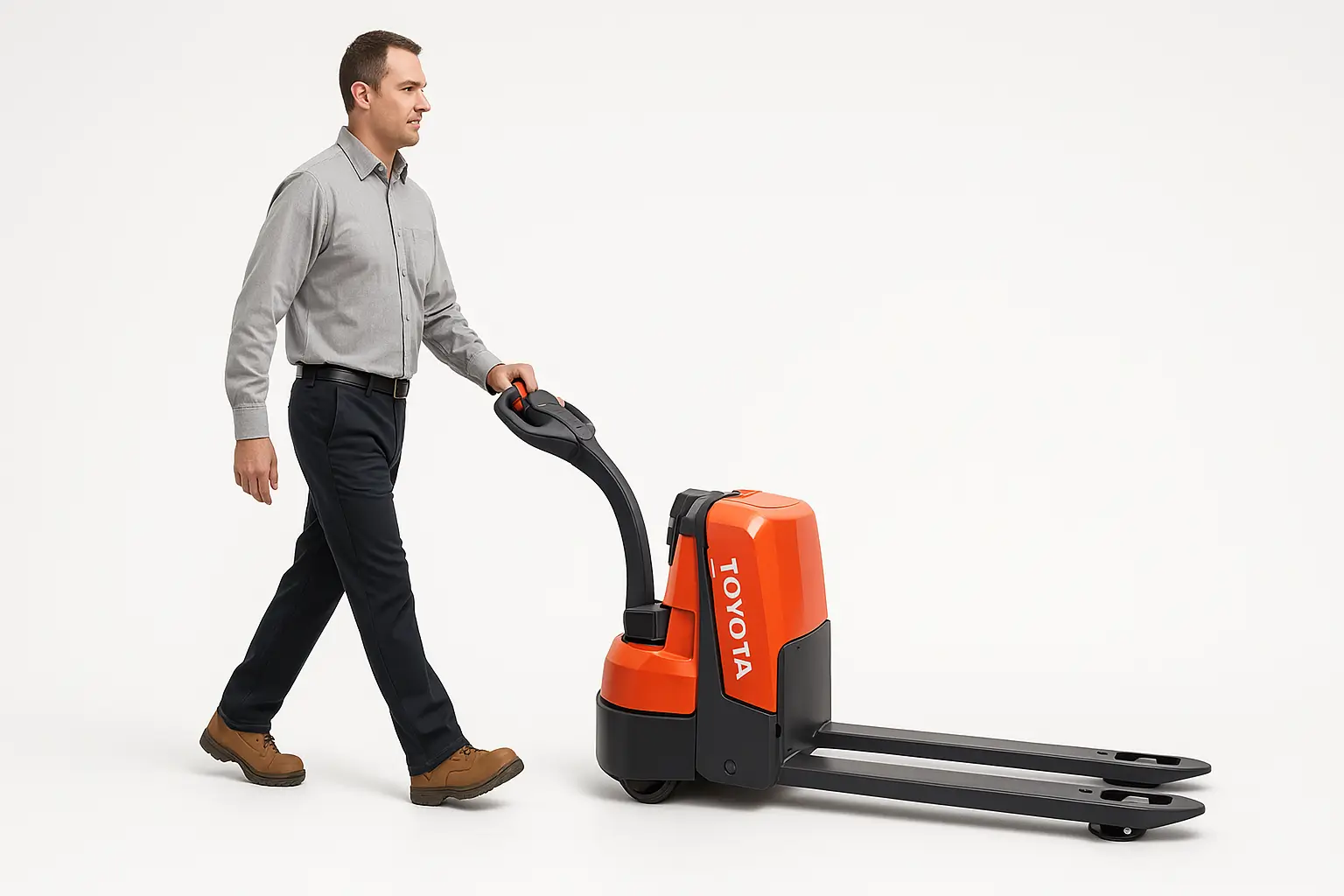Electric pallet jacks are key tools in warehouses and distribution centers. They help operators move palletized loads easily and with little effort. This guide shows you how to use an electric pallet jack safely and effectively. It covers everything from pre-checks to advanced techniques.
Understanding Electric Pallet Jacks
Electric pallet jacks, also known as powered pallet trucks, lift and move pallets. They are often called electric power jacks or walkies. These jacks work best for short distances. Electric pallet jacks use a motor for movement and hydraulics. This feature greatly lessens the physical strain on operators, unlike manual models.
There are two common types of electric pallet jacks:
- Walkers (Walkies): Made for operators to walk in front or behind while using the controls.
- Rider Trucks (Walkie-Riders): Operators can walk beside the truck or stand on the platform to use it.
Key Components
Most electric pallet jacks share these essential components:
- Control handle with directional and speed controls
- Lift and lower buttons
- T-bar support handle
- Horn
- Battery and charging system
- Pallet forks
- Load wheels and steering tires
- Brake controls
- Emergency reverse button
Pre-Operational Inspection
Before operating an electric pallet jack, always perform these important safety checks:
- Visual Inspection: Look for fluid leaks, cracked parts, broken parts, or anything unusual.
- Component Check: Pay special attention to wheels, tires, and forks for signs of damage
- Control Function Test: Check all controls. This includes:
- Forward/reverse movement
- Lifting/lowering functions
- Horn
- Brakes
- Emergency reverse button
- Check the data plate on the vehicle. Make sure it’s there and easy to read. Also, note the maximum load capacity.
- Battery Status: Check that the battery has sufficient charge for your intended operations
Don’t use a broken pallet jack. If you see any problems, tell your supervisor right away.
Understanding the Controls
The control handle, also known as the T-bar, is the main way to operate an electric pallet jack.
Standard Controls
- Throttle/Accelerator: Controls speed and direction. Twist toward you for forward motion, away from you for reverse
- Lift Button: Typically marked with an up arrow, raises the forks
- Lower Button: Typically marked with a down arrow, lowers the forks
- Horn Button: Activates the audible warning signal
- Key Switch: Powers the unit on and off
Safety Features
- Emergency Brake: The handle acts as an emergency brake when it’s upright or horizontal. It stops the pallet jack right away.
- Emergency Stop/Switch: Some models include an emergency stop button. This button cuts power right away.
Step-by-Step Operating Instructions
Starting the Pallet Jack
- Unplug the pallet jack from the battery charger and properly store the charging cord
- Insert the key into the key switch and turn clockwise to the “ON” position
- Conduct a quick test of the controls to ensure proper function
- Press the “down” button to ensure forks are in their lowest position before travel
Basic Movement
- Forward Movement: Hold the controller handle. Twist the throttle/accelerator toward you to go forward.
- Reverse Movement: Twist the controller in the opposite direction to move in reverse
- Steering: Move the control handle from side to side to steer the pallet jack in the desired direction
- Speed Control: The more you twist the accelerator, the faster you go. Turn it further from neutral for increased speed.
- Stopping: To stop gradually, return the throttle to neutral. For an emergency stop, place the handle fully vertical or horizontal.
Approaching and Lifting a Load
- Drive the pallet jack to the pallet location with forks lowered
- Position the jack properly to approach the pallet:
- Approach the pallet squarely with forks aligned with pallet openings
- If space is limited, approach from the side and maneuver as needed
- Slide the forks fully into the pallet, ensuring they extend completely through
- Press the “lift” button to raise the pallet just enough to clear the floor (typically 1-2 inches)
- Ensure the load is stable and balanced before moving
Transporting the Load
- Look in the direction of travel before moving
- For long distances, travel with the load trailing (forks behind you) when possible
- Maintain a safe speed, especially when carrying heavy loads
- Keep the load as low to the floor as possible to maintain a low center of gravity
- Use the horn when approaching intersections or blind corners
- Take corners widely and at reduced speed to prevent load shifting or tipping
- Always face in the direction of travel—don’t walk backwards
Lowering and Releasing the Load
- Bring the pallet jack to a complete stop at the destination
- Ensure the area is clear before lowering the load
- Press the “lower” button to place the pallet on the ground
- When the pallet is fully lowered, carefully pull the jack back to take the forks out from under the pallet.
Parking and Shutting Down
- Lower the forks completely to their lowest position
- Park in a designated area away from traffic, emergency equipment, and exits
- Turn the key switch to the “OFF” position and remove the key
- If finished using the jack for the day, plug it into the battery charger
Safety Guidelines and Best Practices
Load Handling
- Do not exceed the pallet jack’s maximum load capacity. This is usually between 2,000 and 10,000 pounds, depending on the model.
- Ensure the load is stable, properly palletized, and evenly distributed before lifting
- Don’t stack loads too high as this creates falling hazards and visibility issues
- Use extra caution with extra-high or wide loads
Safe Operation
- Always wear appropriate PPE including safety-toe footwear and possibly gloves and eye protection
- Keep all body parts clear of the jack, especially when lowering or raising loads
- Avoid sudden movements that could cause the load to shift or fall
- Never use your body to stop the pallet jack—it can weigh as much as a car when loaded
- Come to a complete stop before changing directions
- Never allow passengers to ride on the pallet jack or load
- Never operate on ramps or inclines unless specifically designed for such use
- Pay extra attention when working around loading docks, truck trailers, and congested areas
- When approaching corners, swing wide and reduce speed
Handling Difficult Situations
If a pallet becomes stuck on the forks, safely remove it by:
- Using the hydraulics to move the forks up and down to loosen it, or
- If that fails, get assistance from a forklift operator to remove it safely
Maintenance and Care
- Charge the battery when not in use to ensure it’s ready for the next shift
- Store the pallet jack with the forks down. Keep it in a spot that won’t cause tripping hazards.
- Report any maintenance issues or damage immediately to supervisors
- Follow manufacturer-recommended maintenance schedules
- Keep wheels clean and free of debris that could affect maneuverability
Useful Table Summarizing
| Aspect | Details |
|---|---|
| Operation | – Pre-operational inspection: check for damage, controls, battery status – Use control handle for movement, lifting, lowering – Follow safety procedures: proper approach, load handling, speed control – Turn off and store properly after use |
| Cost | – Purchase price varies based on capacity and features – Maintenance costs include battery charging, repairs, and inspections – Operational costs are minimal, mainly electricity for charging – Cost-effective for short-distance material handling in warehouses |
| Functionality | – Designed to lift and transport palletized loads – Electric motor reduces physical effort – Features include lift/lower buttons, steering, horn, emergency reverse – Suitable for indoor warehouse use, with varying load capacities |



Leave a Reply